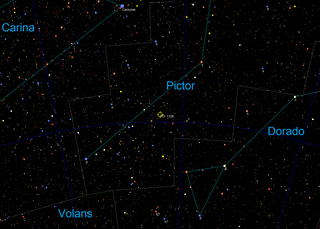astro.wikisort.org - Star
TOI 1338 is a binary star system located in the constellation Pictor, about 1,320 light-years from Earth.[2] It is orbited by the circumbinary planet TOI 1338 b, discovered by the Transiting Exoplanet Survey Satellite (TESS).[4]
 Position of TOI 1338 in Pictor | |
| Observation data Epoch J2000 Equinox J2000 | |
|---|---|
| Constellation | Pictor |
| Right ascension | 06h 08m 31.968s[1] |
| Declination | −59° 32′ 28.08″[1] |
| Apparent magnitude (V) | 11.72[2] |
| Characteristics | |
| Spectral type | F8[3] |
| Variable type | eclipsing[3] |
| Astrometry | |
| Radial velocity (Rv) | 23.56±5.34[1] km/s |
| Proper motion (μ) | RA: −12.057[1] mas/yr Dec.: +34.513[1] mas/yr |
| Parallax (π) | 2.4752 ± 0.0099 mas[1] |
| Distance | 1,318 ± 5 ly (404 ± 2 pc) |
| Orbit[2] | |
| Period (P) | 14.608559+0.00013 −0.00012 d |
| Semi-major axis (a) | 0.1321+0.0024 −0.0025 AU |
| Eccentricity (e) | 0.15603±0.00015 |
| Inclination (i) | 89.696+0.178 −0.114° |
| Semi-amplitude (K1) (primary) | 21.619±0.007 km/s |
| Details[2] | |
| TOI 1338 A | |
| Mass | 1.127+0.068 −0.069 M☉ |
| Radius | 1.331+0.024 −0.026 R☉ |
| Luminosity | 2.1[1] L☉ |
| Surface gravity (log g) | 4.0 cgs |
| Temperature | 6,160 K |
| Metallicity [Fe/H] | +0.01 dex |
| Rotation | 19±3 d |
| Rotational velocity (v sin i) | 3.6 km/s |
| Age | 4.4 Gyr |
| TOI 1338 B | |
| Mass | 0.3128+0.0113 −0.0118 M☉ |
| Radius | 0.3089+0.0056 −0.0060 R☉ |
| Other designations | |
TYC 8533-950-1, EBLM J0608-59, 2MASS J06083197-5932280, RAVE J060832.0-593228 | |
| Database references | |
| SIMBAD | data |
| Extrasolar Planets Encyclopaedia | data |
Nomenclature and history
The acronym TOI stands for "TESS Objects of Interest." The planet was found by Wolf Cukier, a 17-year-old attending Scarsdale High School in New York at the time, [5] who joined the Goddard Space Flight Center as a summer intern. He looked through light curves that were flagged as eclipsing binaries by volunteers of the Planet Hunters citizen science project.[6] Cukier and six of the Planet Hunter volunteers are co-authors of the publication regarding the newly-discovered planet.[2] Cukier currently attends Princeton University as an undergraduate student in the Department of Astrophysical Sciences.[7]
Cukier was not given an opportunity to name the planet.[8] In February 2021, a petition calling for the planet TOI 1338 b in the system to be named SOPHIE received over 90,000 signatures.[9] Organisers of the petition sought to pay homage to the late Scottish musician and music producer Sophie, who died on 30 January 2021.[10] High-profile supporters of the campaign included Charli XCX and Caroline Polachek.[9]
The stellar binary
TOI 1338 is a single-lined spectroscopic binary system, consisting of an F8 star and a red dwarf of spectral type M. The system has an age of 4.4 billion years. The two stars with masses of 1.13 and 0.313 M☉ revolve around each other every 14.6 days. The red dwarf is about nine magnitudes fainter than the primary star and cannot be detected in the spectrum.[11][2]
The orbit of the two stars is inclined at 89.7° and both primary and secondary eclipses can be observed, although the brightness changes are very small. The primary eclipse occurs when the hotter primary star is partially occulted by the cooler secondary. It lasts about five hours and the brightness decreases by about 4%. The secondary eclipses occur when the cooler star is occulted by the hotter star. They also last about five hours but the brightness drops by less than half a percent.[2]
Planetary system

The planet TOI 1338b is between Neptune and Saturn in size, and has an orbit that is within ~1° coplanar with the binary.[2] The spin of the primary star also aligns with the orbits of the binary and the planet (spin-orbit angle β = 2.8±17.1 °). This is the second time the Rossiter–McLaughlin effect was measured for a star hosting a circumbinary planet. Kepler-16 was the first system with such a measurement. The measurement of the alignment for TOI 1338 suggests that the planet formed from a single circumbinary disk.[12]
| Companion (in order from star) |
Mass | Semimajor axis (AU) |
Orbital period (days) |
Eccentricity | Inclination | Radius |
|---|---|---|---|---|---|---|
| b | 33.0±20.0 M🜨 | 0.4607+0.0084 −0.0088 |
95.174+0.031 −0.035 |
0.0880+0.0043 −0.0033 |
89.37+0.35 −0.26° |
6.85±0.19 R🜨 |
See also
- TOI 700
- TOI-849 b
References
- Vallenari, A.; et al. (Gaia Collaboration) (2022). "Gaia Data Release 3. Summary of the content and survey properties". Astronomy & Astrophysics. arXiv:2208.00211. doi:10.1051/0004-6361/202243940. Gaia DR3 record for this source at VizieR.
- Kostov, Veselin B.; Orosz, Jerome A.; Feinstein, Adina D.; Welsh, William F.; Cukier, Wolf; Haghighipour, Nader; Quarles, Billy; Martin, David V.; Montet, Benjamin T.; Torres, Guillermo; Triaud, Amaury H. M. J. (7 May 2020). "TOI-1338: TESS' First Transiting Circumbinary Planet". The Astronomical Journal. 159 (6): 253. arXiv:2004.07783. Bibcode:2020AJ....159..253K. doi:10.3847/1538-3881/ab8a48. hdl:10023/20067. ISSN 1538-3881. S2CID 215785933.
- Triaud, Amaury H. M. J.; Martin, David V.; Ségransan, Damien; Smalley, Barry; Maxted, Pierre F. L.; Anderson, David R.; Bouchy, François; Collier Cameron, Andrew; Faedi, Francesca; Gómez Maqueo Chew, Yilen; Hebb, Leslie; Hellier, Coel; Marmier, Maxime; Pepe, Francesco; Pollacco, Don; Queloz, Didier; Udry, Stéphane; West, Richard (2017). "The EBLM Project. IV. Spectroscopic orbits of over 100 eclipsing M dwarfs masquerading as transiting hot Jupiters". Astronomy and Astrophysics. 608: A129. arXiv:1707.07521. Bibcode:2017A&A...608A.129T. doi:10.1051/0004-6361/201730993. S2CID 119372451.
- "ExoFOP TIC 260128333". exofop.ipac.caltech.edu. Retrieved 9 January 2020.
- Pereira, Ivan (9 January 2020). "New York teen discovers new planet while interning with NASA". ABC News.
- "Discovery Alert! High School Student Finds a World With Two Suns". Exoplanet Exploration: Planets Beyond our Solar System. Retrieved 14 February 2020.
- Cukier, Wolf. "Wolf Cukier - Department of Astrophysical Sciences". Princeton Edu. © 2022 The Trustees of Princeton University.
- Morrison, Hannah (16 January 2020). "Meet the NASA intern who discovered a new planet on his third day". BBC News. London, England. Retrieved 3 October 2021.
- "SOPHIE fans call for NASA to name a planet after the late musician". Dazed. 3 February 2021. Retrieved 4 February 2021.
- Richards, Will (30 January 2021). "DJ and producer SOPHIE has died". NME. Archived from the original on 30 January 2021. Retrieved 31 January 2021.
- Martin, David V.; Triaud, Amaury H. M. J.; Udry, Stephane; Marmier, Maxime; Maxted, Pierre F. L.; Cameron, Andrew Collier; Hellier, Coel; Pepe, Francesco; Pollacco, Don; Segransan, Damien; West, Richard (April 2019). "The BEBOP radial-velocity survey for circumbinary planets I. Eight years of CORALIE observations of 47 single-line eclipsing binaries and abundance constraints on the masses of circumbinary planets". Astronomy & Astrophysics. 624: A68. arXiv:1901.01627. Bibcode:2019A&A...624A..68M. doi:10.1051/0004-6361/201833669. ISSN 0004-6361.
- Kunovac Hodzic, Vedad; Triaud, Amaury H. M. J.; Martin, David V.; Fabrycky, Daniel C.; Cegla, Heather M.; Collier Cameron, Andrew; Gill, Samuel; Hellier, Coel; Kostov, Veselin B.; Maxted, Pierre F. L.; Orosz, Jerome A. (1 July 2020). "The EBLM project - VII. Spin-orbit alignment for the circumbinary planet host EBLM J0608-59 A/TOI-1338 A". Monthly Notices of the Royal Astronomical Society. 497 (2): 1627–1633. arXiv:2007.05514. Bibcode:2020MNRAS.497.1627K. doi:10.1093/mnras/staa2071. S2CID 220486377.
External links
- TESS – Official WebSite
- NASA Telescope Discovers Its First Planet Orbiting Two Stars
- TOI 1338 at ExoFOP TESS
- The TOI 1338 subject at Planet Hunters, as mentioned in the paper
На других языках
[de] TOI 1338
TOI 1338 ist ein binäres Sternsystem im Sternbild Maler, das von einem Planeten umkreist wird. Die Entdeckung erfolgte mittels Daten, die vom Weltraumteleskop TESS erfasst wurden. Wolf Cukier, Schüler der Scarsdale High School in Scarsdale, erkannte sie während des dritten Tags seines Sommerpraktikums 2019 am Goddard Space Flight Center der NASA als Signatur eines Exoplaneten.[4][5] Das System ist ungefähr 1300 Lichtjahre vom Sonnensystem entfernt. Es besteht aus einem Stern TOI 1338 A mit 1,2 Sonnenmassen, der von einem weiteren Stern TOI 1338 B mit 0,325 Sonnenmassen in 14,6 Tagen umkreist wird.[6] Das Massezentrum beider Sterne wird vom zirkumbinären Exoplaneten TOI 1338b innerhalb von 71,4 (± 0,13) Tagen umrundet.[3][7] Der Exoplanet TOI 1338b hat den Messungen von TESS zufolge eine Masse von 6,5 Erdmassen. Die NASA veröffentlichte die Entdeckung auf ihrer Homepage am 7. Januar 2020.[5] Aufgrund seiner südlichen Lage kann das System TOI 1338 von Deutschland aus nicht gesehen werden, obwohl der Hauptstern mit einer scheinbaren Helligkeit von 12 mag hell genug für ein Teleskop mit einer Öffnung von 200 mm ist.- [en] TOI 1338
Другой контент может иметь иную лицензию. Перед использованием материалов сайта WikiSort.org внимательно изучите правила лицензирования конкретных элементов наполнения сайта.
WikiSort.org - проект по пересортировке и дополнению контента Википедии



